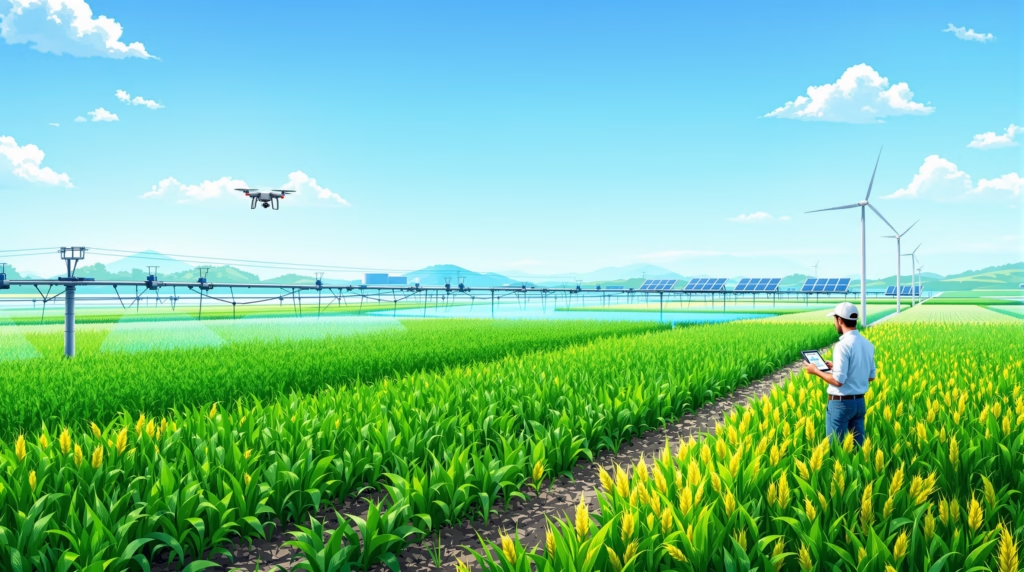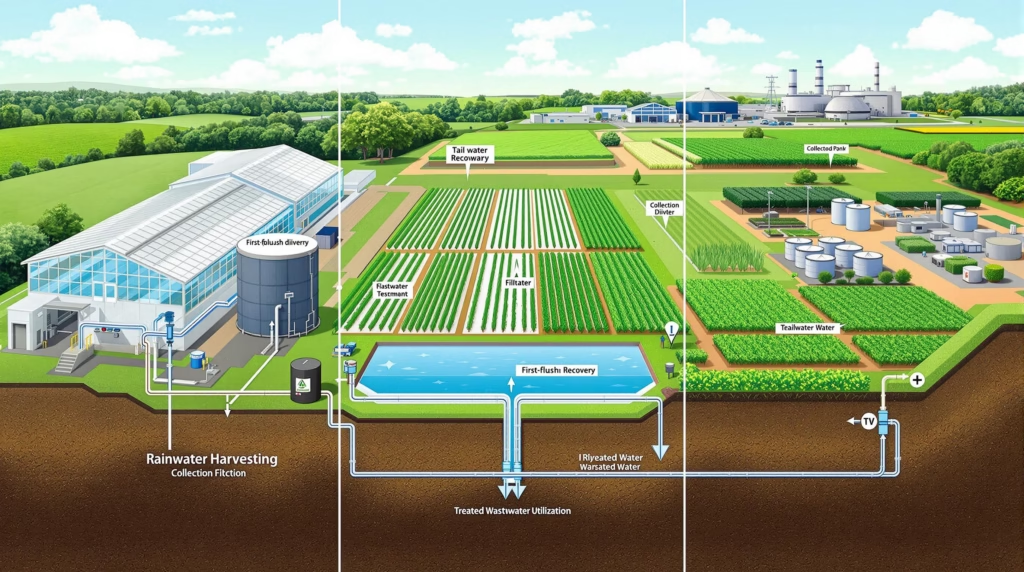Confronting Water Scarcity in Agricultural Production
Agriculture accounts for approximately 70% of global freshwater withdrawals, placing immense pressure on this increasingly scarce resource. As climate change alters precipitation patterns and increases evaporation rates, while population growth drives food demand, the imperative for water-efficient farming has never been more urgent. Traditional irrigation methods often operate at efficiencies below 50%, with substantial losses to evaporation, runoff, and drainage beyond the root zone. Agricultural water management has evolved dramatically in recent decades, transitioning from volume-based approaches to precision techniques that deliver the right amount of water, at the right time, in the right location. This revolution in water stewardship combines technological innovation with improved understanding of crop-water relationships to maximize productivity per drop—a concept known as water productivity.
Advanced Irrigation Technologies
Modern irrigation systems optimize water delivery through several innovative approaches:
- Precision Drip Irrigation
Beyond basic drip systems, next-generation technologies incorporate soil moisture sensing, weather data, and crop growth models to automate irrigation scheduling. Subsurface drip irrigation (SDI) places water directly in the root zone, virtually eliminating surface evaporation and reducing weed pressure. Research indicates water savings of 30-60% compared to conventional methods while maintaining or increasing yields. - Variable Rate Irrigation
Adapting center pivot and linear move systems with individually controlled sprinklers allows water application rates to vary across fields based on soil characteristics, topography, and crop needs. This site-specific approach addresses field variability that uniform irrigation methods cannot accommodate, reducing overwatering in low areas while ensuring adequate moisture in high-demand zones. - Micro-Irrigation for Specialty Crops
Specialized emitters designed for perennial crops like vineyards, orchards, and berries deliver precise water volumes directly to individual plants. These systems often incorporate fertigation—the application of water-soluble fertilizers through irrigation—enhancing nutrient use efficiency alongside water conservation. - Controlled Deficit Irrigation
Strategic application of water stress during specific crop development stages can actually improve product quality in certain crops while reducing water consumption. This approach requires sophisticated monitoring but has shown particular promise in wine grapes, tree fruits, and processing tomatoes, where moderate stress enhances flavor compounds and sugar concentration.

Water Monitoring and Decision Support
Technological advances enable unprecedented precision in water management decisions:
- Soil Moisture Sensing Networks
Distributed sensors at multiple depths throughout fields provide real-time data on water availability in the root zone. Advanced systems integrate wireless connectivity and cloud-based platforms, allowing farmers to monitor conditions remotely and receive irrigation recommendations based on actual soil conditions rather than calendar schedules. - Remote Sensing Applications
Satellite imagery, drone-mounted cameras, and ground-based sensors detect crop water stress through spectral signatures invisible to the human eye. Thermal imaging reveals temperature differences between well-watered and water-stressed plants before visual symptoms appear, enabling proactive irrigation management. - Weather-Based Irrigation Controllers
Smart irrigation systems incorporate local weather data and evapotranspiration calculations to adjust water delivery based on atmospheric conditions. These systems automatically reduce irrigation during cooler periods or after rainfall events, preventing overwatering while maintaining optimal soil moisture. - Artificial Intelligence and Predictive Analytics
Machine learning algorithms process multiple data streams—historical weather patterns, soil characteristics, crop growth stages, and real-time sensor readings—to forecast irrigation needs days in advance. These predictive capabilities help farmers optimize water applications in anticipation of changing conditions.
Water Capture and Recycling Systems
Beyond efficiency improvements, capturing and reusing water creates closed-loop systems:
- Rainwater Harvesting
Strategic collection of precipitation from building roofs, greenhouse covers, and other surfaces provides supplemental water sources for irrigation. Sophisticated systems include first-flush diversion, filtration, and automated distribution components to ensure water quality and efficient delivery. - Tailwater Recovery
Recapturing irrigation runoff from field edges through collection ponds and filtration systems allows reuse of water that would otherwise be lost. These systems reduce both water consumption and potential environmental impacts from nutrient-rich runoff entering natural waterways. - Treated Wastewater Utilization
Agricultural reuse of treated municipal wastewater—sometimes called reclaimed or recycled water—transforms a disposal challenge into a valuable resource. When properly managed with appropriate crops and handling protocols, this practice safely stretches water supplies while providing plants with beneficial nutrients contained in the water.

Agronomic Practices Enhancing Water Productivity
Water management extends beyond irrigation technology to include complementary field practices:
- Conservation Tillage and Residue Management
Reducing soil disturbance and maintaining crop residues on the soil surface significantly decreases evaporative losses while improving infiltration rates. These practices can reduce irrigation requirements by 10-25% in many cropping systems by preserving soil moisture between irrigation events. - Drought-Tolerant Crop Varieties
Plant breeding programs have developed cultivars with enhanced water-use efficiency and drought tolerance through both conventional selection and molecular techniques. These varieties maintain productivity under water-limited conditions through mechanisms like deeper rooting, modified stomatal behavior, and enhanced osmotic adjustment. - Landscape-Level Water Management
Practices like terracing, contour farming, and installation of vegetative buffer strips slow water movement across the landscape, increasing infiltration and reducing erosion. These approaches help convert more rainfall into plant-available soil moisture, reducing irrigation demands.
Implementation Challenges and Solutions
Adopting advanced water management approaches involves overcoming several barriers:
- Economic Considerations
High initial investment costs for precision irrigation technologies can deter adoption despite long-term benefits. Cost-sharing programs, equipment leasing options, and valuation of ecosystem services help address these financial challenges. - Technical Knowledge Requirements
Operating advanced water management systems demands new skills and understanding. Farmer networks, extension services, and supplier training programs build capacity for successful implementation. - Water Rights and Regulatory Frameworks
Outdated water allocation systems sometimes discourage efficiency improvements by penalizing reduced use. Modernized policies that allow farmers to benefit from conservation while protecting environmental flows create appropriate incentives. - System Integration
Maximizing benefits requires coordinating water management with other farm operations including nutrient application, pest management, and harvest timing. Whole-farm planning approaches help optimize these interactions.
The Future of Agricultural Water Management
As technology continues advancing and water scarcity intensifies, several trends will shape agricultural water use:
- Autonomous Irrigation Systems
Self-adjusting irrigation systems that integrate multiple data sources and operate with minimal human intervention represent the next frontier in water management. These systems continuously optimize water application based on real-time conditions and crop needs. - Watershed-Scale Coordination
Recognizing that water management extends beyond individual farm boundaries, collaborative approaches allow producers within watersheds to coordinate storage, timing of withdrawals, and improvement of overall water quality. - Water Markets and Valuation
Developing frameworks that accurately value water and allow for flexible allocation helps ensure this scarce resource flows to its highest-value uses while compensating conservation efforts. - Climate-Resilient Design
Future water systems will increasingly incorporate climate resilience principles—designing for both drought and flood conditions, diversifying water sources, and building redundancy into critical infrastructure.
By embracing these innovations in agricultural water management, farmers can navigate the growing challenges of water scarcity while maintaining productive and profitable operations. The transition from volume-based to precision approaches not only conserves a precious natural resource but often enhances crop quality, reduces energy consumption, and minimizes environmental impacts—truly a win-win scenario for agriculture and ecosystems alike.
References
- Levidow, L., Zaccaria, D., Maia, R., et al. (2014). Improving water-efficient irrigation: Prospects and difficulties of innovative practices. Agricultural Water Management, 146, 84-94.
- Chartzoulakis, K., & Bertaki, M. (2015). Sustainable water management in agriculture under climate change. Agriculture and Agricultural Science Procedia, 4, 88-98.
- Jägermeyr, J., Gerten, D., Heinke, J., et al. (2015). Water savings potentials of irrigation systems: Global simulation of processes and linkages. Hydrology and Earth System Sciences, 19, 3073-3091.
- Sadler, E. J., Evans, R. G., Stone, K. C., & Camp, C. R. (2005). Opportunities for conservation with precision irrigation. Journal of Soil and Water Conservation, 60(6), 371-378.
- Liang, X., Liakos, V., Wendroth, O., & Vellidis, G. (2016). Scheduling irrigation using an approach based on the van Genuchten model. Agricultural Water Management, 176, 170-179.
For those seeking to understand and implement water management systems, explore Agri AI: Smart Farming Advisor that can provide you with relevant insights .

Leave a Reply